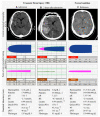Acute Haemostatic Depletion and Failure in Patients with Traumatic Brain Injury (TBI): Pathophysiological and Clinical Considerations
- PMID: 37109145
- PMCID: PMC10143480
- DOI: 10.3390/jcm12082809
Acute Haemostatic Depletion and Failure in Patients with Traumatic Brain Injury (TBI): Pathophysiological and Clinical Considerations
Abstract
Background: Because of the aging population, the number of low falls in elderly people with pre-existing anticoagulation is rising, often leading to traumatic brain injury (TBI) with a social and economic burden. Hemostatic disorders and disbalances seem to play a pivotal role in bleeding progression. Interrelationships between anticoagulatoric medication, coagulopathy, and bleeding progression seem to be a promising aim of therapy.
Methods: We conducted a selective search of the literature in databases like Medline (Pubmed), Cochrane Library and current European treatment recommendations using relevant terms or their combination.
Results: Patients with isolated TBI are at risk for developing coagulopathy in the clinical course. Pre-injury intake of anticoagulants is leading to a significant increase in coagulopathy, so every third patient with TBI in this population suffers from coagulopathy, leading to hemorrhagic progression and delayed traumatic intracranial hemorrhage. In an assessment of coagulopathy, viscoelastic tests such as TEG or ROTEM seem to be more beneficial than conventional coagulation assays alone, especially because of their timely and more specific gain of information about coagulopathy. Furthermore, results of point-of-care diagnostic make rapid "goal-directed therapy" possible with promising results in subgroups of patients with TBI.
Conclusions: The use of innovative technologies such as viscoelastic tests in the assessment of hemostatic disorders and implementation of treatment algorithms seem to be beneficial in patients with TBI, but further studies are needed to evaluate their impact on secondary brain injury and mortality.
Keywords: coagulopathy; diagnostics; mechanisms; traumatic brain injury; treatment.
Conflict of interest statement
The authors declare no conflict of interest.
Figures





Similar articles
-
Coagulopathy and Progression of Intracranial Hemorrhage in Traumatic Brain Injury: Mechanisms, Impact, and Therapeutic Considerations.Neurosurgery. 2021 Nov 18;89(6):954-966. doi: 10.1093/neuros/nyab358. Neurosurgery. 2021. PMID: 34676410 Review.
-
The impact of pre-injury anticoagulation therapy in the older adult patient experiencing a traumatic brain injury: A systematic review.JBI Libr Syst Rev. 2012;10(58):4610-4621. doi: 10.11124/jbisrir-2012-429. JBI Libr Syst Rev. 2012. PMID: 27820526
-
Global Characterisation of Coagulopathy in Isolated Traumatic Brain Injury (iTBI): A CENTER-TBI Analysis.Neurocrit Care. 2021 Aug;35(1):184-196. doi: 10.1007/s12028-020-01151-7. Epub 2020 Dec 11. Neurocrit Care. 2021. PMID: 33306177 Free PMC article.
-
Thromboelastography is a Marker for Clinically Significant Progressive Hemorrhagic Injury in Severe Traumatic Brain Injury.Neurocrit Care. 2021 Dec;35(3):738-746. doi: 10.1007/s12028-021-01217-0. Epub 2021 Apr 12. Neurocrit Care. 2021. PMID: 33846901
-
Use of Thromboelastography in the Evaluation and Management of Patients With Traumatic Brain Injury: A Systematic Review and Meta-Analysis.Crit Care Explor. 2021 Sep 14;3(9):e0526. doi: 10.1097/CCE.0000000000000526. eCollection 2021 Sep. Crit Care Explor. 2021. PMID: 34549189 Free PMC article. Review.
Cited by
-
Traumatic Brain Injury in Patients under Anticoagulant Therapy: Review of Management in Emergency Department.J Clin Med. 2024 Jun 24;13(13):3669. doi: 10.3390/jcm13133669. J Clin Med. 2024. PMID: 38999235 Free PMC article. Review.
-
Traumatic Brain Injury as an Independent Predictor of Futility in the Early Resuscitation of Patients in Hemorrhagic Shock.J Clin Med. 2024 Jul 3;13(13):3915. doi: 10.3390/jcm13133915. J Clin Med. 2024. PMID: 38999481 Free PMC article. Review.
-
Time-Dependent Association of Preinjury Anticoagulation on Traumatic Brain Injury-Induced Coagulopathy: A Retrospective, Multicenter Cohort Study.Neurosurgery. 2024 Oct 24;96(5):1099-112. doi: 10.1227/neu.0000000000003238. Online ahead of print. Neurosurgery. 2024. PMID: 39446739
References
-
- Maas A.I.R., Menon D.K., Adelson P.D., Andelic N., Bell M.J., Belli A., Bragge P., Brazinova A., Büki A., Chesnut R.M., et al. Traumatic Brain Injury: Integrated Approaches to Improve Prevention, Clinical Care, and Research. Lancet Neurol. 2017;16:987–1048. doi: 10.1016/S1474-4422(17)30371-X. - DOI - PubMed
Publication types
LinkOut - more resources
Full Text Sources

